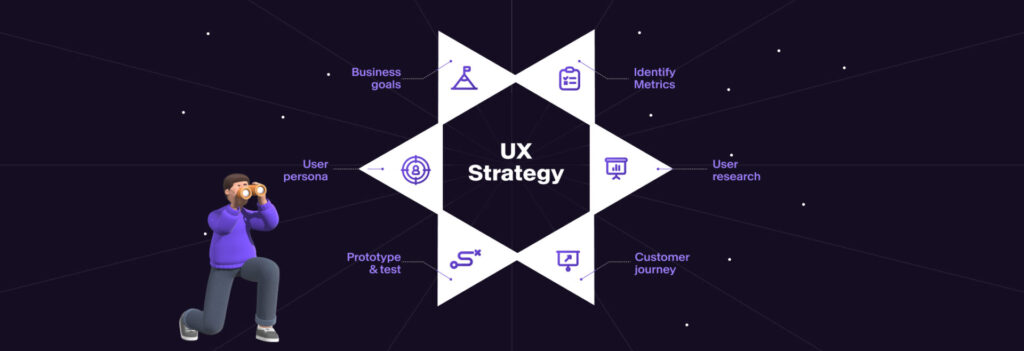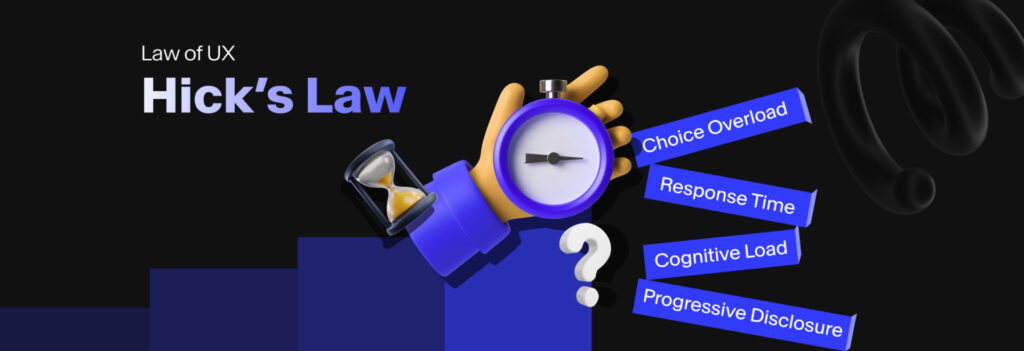Advanced Personalization Strategies Elevating User Experiences

Personalization has evolved beyond being a mere trend in product design. It is now a necessity for businesses to engage users seamlessly and improve the overall user experience through intuitive design to build brand loyalty among the audience. Successful personalization strategies help brands deliver personalized customer experiences by leveraging the user data accumulated through existing […]
Crafting a Winning UX Strategy for Pioneering Digital Experiences

Launching a new digital product? If you are looking to create a digital product that not only provides functional value to the users but also keeps them engaged, user research is where you must begin. The foundation of a great product is building a solid UX strategy, and that starts with understanding real users and […]
Understanding Hick’s Law and Its Application in UX Design

To fully appreciate Hick’s Law in UX Design, it’s important first to understand the decision-making process. When a user is presented with too many options, the brain has to filter out unnecessary information, leading to what is known as choice overload. This can result in frustration, abandonment of the task, or even decision fatigue, where […]
The Role of Signifiers in UX: Mapping User Expectations

Imagine you’re browsing a website, and you come across a button labeled “Click me!” What would you expect to happen when you click it? Would it take you to a new page, open a modal, or perhaps trigger an animation? The answer lies in the signifiers – the visual, auditory, or tactile cues that communicate […]
Gamification in User Experience: Elevating Engagement and Retention

In today’s digital age, maintaining user engagement and motivation is a critical challenge for developers and designers. One effective strategy that has gained popularity is gamification. Gamification in UI/UX design has become an essential strategy to increase user engagement, motivate users, and create a sense of accomplishment. It involves integrating game design elements into non-game […]
Achieving Business Success: Choosing the Right UI UX Agency

First impressions are everything—especially in today’s digital age. But it’s more than just looks that have users staying loyal to a product or organization. The user experiences across touchpoints and the impact you make as a product often equate to lasting impressions. Thus, the role of UI/UX design in business success cannot be overstated.A well-designed […]
From UX to the Visuals: The Essential Roles in Your Design Team

The success of a product in this digital era is marked by critical aspects that ultimately boil down to how accessible it is. It hinges not only on its functionality but also on how it feels and looks to the user. A well-rounded design team is essential for creating products that are not only usable […]
User Experience-led KPIs for Digital Products or Services

In the increasingly competitive landscape of digital products and services, user experience (UX) has emerged as a critical factor that determines the success of digital products or services. While traditional market-oriented performance indicators such as revenue, market share, and overall profit remain important to gauge the business and its success, KPIs that help us monitor […]
Wearables UX & Smartwatch UI Design & Development

In the rapidly evolving landscape of technology, wearable devices have emerged as a significant player, seamlessly integrating into our daily lives. Among these, smartwatches stand out, blending aesthetics with function. As we move toward highly personalized and integrated experiences, understanding key principles to design for wearable technology is essential. Stuti Mazumdar & Vidhi Tiwari – […]
11 Elements to Consider When Designing a Mobile Application

In today’s fast-paced digital era, mobile devices have transformed the way we interact, work, and entertain ourselves. People across the globe, of all ages, find themselves glued to their phones for at least some part of the day as their daily routine. And with a mobile application designed to cater to every need of a […]